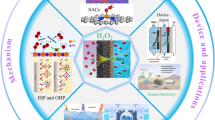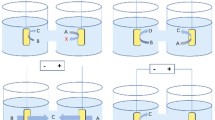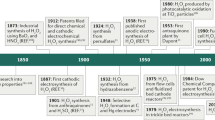Abstract
The paired electrolytic system is constructed by combining the valuable organic electro-oxidation and electro-reduction reactions, which can replace the ineffective water splitting half-reaction. By reducing the energy consumption of the electrolytic cell, the value-added electrolysis is realized. The indirect electrolysis method greatly reduces the dependence of the organic electrolysis reaction on electrode potential by introducing the redox mediators, which solves the problem on the matching of anode and cathode current under potentiostatic conditions. Here, we report a more stable, efficient and energy-saving linear paired electrochemical synthesis system that can simultaneously convert furfural to furoic acid at both the anode and cathode at higher current densities. Stable three-dimensional networked PbO2 is used as the anode and the catalytic amount of 2,2,6,6-tetramethyl-1-piperidinyloxy (TEMPO) is used as the mediator to realize the efficient conversion of furfural to furoic acid in a wide potential range. The cathode catalyzes two-electron oxygen reduction to hydrogen peroxide using Pb/RHPC gas-diffusion electrode, which mediates the oxidation of furfural to furoic acid simultaneously. In potentiostatic electrolysis, the selectivity of the furoic acid in the cathode and anode is 33.2% and 99.3%, respectively, and the total electron efficiency is 127.1%. The properties of the cathode and anode remain stable after the long-time electrolysis in a flow cell. By choosing a stable anode with high oxygen evolution overpotential and a gas-diffusion cathode with high hydrogen evolution overpotential, the electrolytic cell can be operated efficiently and stably by introducing reasonable mediated reactions. The two half-reactions have good compatibility during the electrolysis process, saving energy consumption by about 12.3%, for certain industrial application prospects.

Similar content being viewed by others
References
Yan M, Kawamata Y, Baran PS. Chem Rev, 2017, 117: 13230–13319
Möhle S, Zirbes M, Rodrigo E, Gieshoff T, Wiebe A, Waldvogel SR. Angew Chem Int Ed, 2018, 57: 6018–6041
Leech MC, Garcia AD, Petti A, Dobbs AP, Lam K. React Chem Eng, 2020, 5: 977–990
Holade Y, Tuleushova N, Tingry S, Servat K, Napporn TW, Guesmi H, Cornu D, Kokoh KB. Catal Sci Technol, 2020, 10: 3071–3112
Du L, Shao Y, Sun J, Yin G, Du C, Wang Y. Catal Sci Technol, 2018, 8: 3216–3232
Li K, Sun Y. Chem Eur J, 2018, 24: 18258–18270
Simoska O, Rhodes Z, Weliwatte S, Cabrera-Pardo JR, Gaffney EM, Lim K, Minteer SD. ChemSusChem, 2021, 14: 1674–1686
Li X, Jia P, Wang T. ACS Catal, 2016, 6: 7621–7640
Kwon Y, Schouten KJP, van der Waal JC, de Jong E, Koper MTM. ACS Catal, 2016, 6: 6704–6717
Jung S, Biddinger EJ. ACS Sustain Chem Eng, 2016, 4: 6500–6508
Verdeguer P, Merat N, Gaset A. Appl Catal A-Gen, 1994, 112: 1–11
Verdeguer P, Merat N, Rigal L, Gaset A. J Chem Tech & Biotech, 1994, 61: 97–102
Yang D, Ma C, Peng B, Xu J, He YC. Industrial Crops Products, 2020, 153: 112580
Zhang S, Li L, Li J, Shi J, Xu K, Gao W, Zong L, Li G, Findlater M. Angew Chem Int Ed, 2021, 60: 7275–7282
Zhang P, Sheng X, Chen X, Fang Z, Jiang J, Wang M, Li F, Fan L, Ren Y, Zhang B, Timmer BJJ, Ahlquist MSG, Sun L. Angew Chem Int Ed, 2019, 58: 9155–9159
Sherbo RS, Delima RS, Chiykowski VA, MacLeod BP, Berlinguette CP. Nat Catal, 2018, 1: 501–507
Martínez NP, Isaacs M, Nanda KK. New J Chem, 2020, 44: 5617–5637
Chadderdon XH, Chadderdon DJ, Pfennig T, Shanks BH, Li W. Green Chem, 2019, 21: 6210–6219
Cao Y, Knijff J, Delparish A, d’Angelo MFN, Noël T. ChemSusChem, 2021, 14: 590–594
Zhang X, Han M, Liu G, Wang G, Zhang Y, Zhang H, Zhao H. Appl Catal B-Environ, 2019, 244: 899–908
Parpot P, Bettencourt AP, Chamoulaud G, Kokoh KB, Belgsir EM. Electrochim Acta, 2004, 49: 397–403
Chamoulaud G, Floner D, Moinet C, Lamy C, Belgsir EM. Electrochim Acta, 2001, 46: 2757–2760
Llorente MJ, Nguyen BH, Kubiak CP, Moeller KD. J Am Chem Soc, 2016, 138: 15110–15113
Ibanez JG, Frontana-Uribe BA, Vasquez-Medrano R. J Mex Chem Soc, 2016, 60: 247–260
Li R, Xiang K, Peng Z, Zou Y, Wang S. Adv Energy Mater, 2021, 11: 2102292
Li W, Nonaka T. J Electrochem Soc, 1999, 146: 592–599
Shen Y, Atobe M, Li W, Nonaka T. Electrochim Acta, 2003, 48: 1041–1046
Strehl J, Abraham ML, Hilt G. Angew Chem Int Ed, 2021, 60: 9996–10000
Li X, Cong L, Lin H, Liu F, Fu X, Xu HC, Lin N. Green Energy Environ, 2022, DOI:https://doi.org/10.1016/j.gee.2022.05.009
Zhang Q, Guo X, Cao X, Wang D, Wei J. Chin J Catal, 2015, 36: 975–981
Li X, Xu H, Yan W. Appl Surf Sci, 2016, 389: 278–286
Wu J, Zhu K, Xu H, Yan W. Chin J Catal, 2019, 40: 917–927
Kubota SR, Choi KS. ACS Sustain Chem Eng, 2018, 6: 9596–9600
Xia H, Li HL. J Electroanal Chem, 1997, 430: 183–187
Tong J, Dang XJ, Li HL. Electroanalysis, 1997, 9: 165–168
Saila P, Hunsom M. Korean J Chem Eng, 2015, 32: 2412–2417
Rafiee M, Miles KC, Stahl SS. J Am Chem Soc, 2015, 137: 14751–14757
Mohebbati N, Prudlik A, Scherkus A, Gudkova A, Francke R. ChemElectroChem, 2021, 8: 3837–3843
Ciriminna R, Ghahremani M, Karimi B, Pagliaro M. ChemistryOpen, 2017, 6: 5–10
Chadderdon DJ, Wu LP, McGraw ZA, Panthani M, Li W. ChemElectroChem, 2019, 6: 3387–3392
Cha HG, Choi KS. Nat Chem, 2015, 7: 328–333
Semmelhack MF, Schmid CR, Cortés DA. Tetrahedron Lett, 1986, 27: 1119–1122
Schnatbaum K, Schäfer HJ. Synthesis, 1999, 1999: 864–872
Bragd PL, van Bekkum H, Besemer AC. Top Catal, 2004, 27: 49–66
Sa YJ, Kim JH, Joo SH. Angew Chem Int Ed, 2019, 58: 1100–1105
Kim HW, Ross MB, Kornienko N, Zhang L, Guo J, Yang P, McCloskey BD. Nat Catal, 2018, 1: 282–290
Lu Z, Chen G, Siahrostami S, Chen Z, Liu K, Xie J, Liao L, Wu T, Lin D, Liu Y, Jaramillo TF, Nørskov JK, Cui Y. Nat Catal, 2018, 1: 156–162
Wang L, Zhang H, Zhang W, Guo H, Cao G, Zhao H, Yang Y. Chem Eng J, 2018, 337: 201–209
Kashani-Motlagh MM, Mahmoudabad MK. J Sol-Gel Sci Technol, 2011, 59: 106–110
Liu D, Zhang W, Lin H, Li Y, Lu H, Wang Y. J Cleaner Production, 2016, 112: 1190–1198
Acknowledgements
This work is supported by the National Key Research and Development Program of China (2017YFB0307500).
Author information
Authors and Affiliations
Corresponding authors
Ethics declarations
Conflict of interest The authors declare no conflict of interest.
Additional information
Supporting information The supporting information is available online at https://chem.scichina.com and https://link.springer.com/journal/11426. The supporting materials are published as submitted, without typesetting or editing. The responsibility for scientific accuracy and content remains entirely with the authors.
Rights and permissions
About this article
Cite this article
Li, X., Cong, L., Lin, H. et al. Electrochemical conversion of furfural to furoic acid: a more stable, efficient and energy-saving system. Sci. China Chem. 65, 2576–2587 (2022). https://doi.org/10.1007/s11426-022-1404-x
Received:
Accepted:
Published:
Issue Date:
DOI: https://doi.org/10.1007/s11426-022-1404-x




